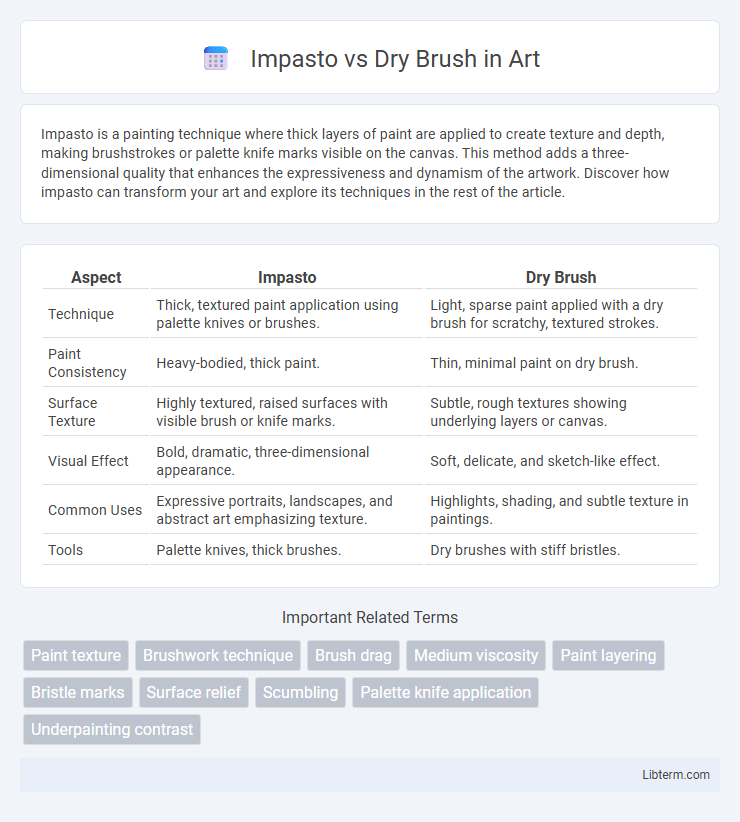Impasto is a painting technique where thick layers of paint are applied to create texture and depth, making brushstrokes or palette knife marks visible on the canvas. This method adds a three-dimensional quality that enhances the expressiveness and dynamism of the artwork. Discover how impasto can transform your art and explore its techniques in the rest of the article.
Table of Comparison
| Aspect | Impasto | Dry Brush |
|---|---|---|
| Technique | Thick, textured paint application using palette knives or brushes. | Light, sparse paint applied with a dry brush for scratchy, textured strokes. |
| Paint Consistency | Heavy-bodied, thick paint. | Thin, minimal paint on dry brush. |
| Surface Texture | Highly textured, raised surfaces with visible brush or knife marks. | Subtle, rough textures showing underlying layers or canvas. |
| Visual Effect | Bold, dramatic, three-dimensional appearance. | Soft, delicate, and sketch-like effect. |
| Common Uses | Expressive portraits, landscapes, and abstract art emphasizing texture. | Highlights, shading, and subtle texture in paintings. |
| Tools | Palette knives, thick brushes. | Dry brushes with stiff bristles. |
Understanding Impasto: Definition and Origins
Impasto is a painting technique characterized by thick, textured layers of paint applied with a palette knife or brush, creating a three-dimensional effect on the canvas. Originating in the Renaissance period, impasto was notably used by artists like Rembrandt and later popularized by Impressionists such as Vincent van Gogh to convey emotion and dynamic movement. This method enhances the visual impact by emphasizing brushstrokes and texture, contrasting sharply with the Dry Brush technique's thin, barely translucent layers.
What Is Dry Brush Technique?
Dry brush technique involves using a brush with very little paint, applied in a dry state to create textured, scratchy strokes that emphasize surface detail and grain. Unlike the thick, raised texture of impasto, dry brushing produces fine, delicate lines that highlight subtle contrasts and enhance realism in paintings. Artists often use dry brush to simulate textures like hair, grass, or fabric by lightly dragging the brush over a rough surface.
Key Differences Between Impasto and Dry Brush
Impasto employs thick layers of paint to create textured, three-dimensional surfaces, while dry brush technique uses minimal paint and a dry brush to produce scratchy, textured strokes with visible brush marks. Impasto emphasizes volume and depth by building up paint physically on the canvas, whereas dry brush prioritizes surface texture and fine detail with controlled, light application. Artists choose impasto for expressive, tactile effects and dry brush for subtle textures and intricate details.
Materials and Tools Needed for Each Technique
Impasto painting requires thick, heavy-bodied acrylics or oil paints along with palette knives and stiff bristle brushes to manipulate the textured paint layers, emphasizing volume and tactile effects. Dry brush technique uses minimal paint applied with stiff, dry brushes or bristle brushes on textured paper or canvas, creating crisp, textured strokes without heavy pigment buildup. Both methods demand specific brush types and paint consistencies matching their unique application styles, influencing the final artwork's texture and detail.
Applications of Impasto in Modern Art
Impasto techniques in modern art are widely applied to create textured, expressive surfaces that enhance the emotional intensity of a painting. Artists use thick layers of oil or acrylic paint to build three-dimensional effects, often highlighting brushstrokes or palette knife marks to add dynamic movement. This technique contrasts with the dry brush method, which employs minimal paint for subtle, textured details rather than bold, tactile impressions.
Dry Brush: Techniques and Effects
Dry brush technique involves using a minimal amount of paint on a stiff brush to create textured, scratchy strokes that reveal underlying layers of the canvas or paper. It is ideal for capturing fine details, rough textures, and subtle gradations without fully covering the surface, producing a sense of depth and movement. Unlike impasto, which emphasizes thick, raised paint, dry brushing offers a more delicate, controlled effect perfect for highlighting contours and adding atmospheric touches.
Effects on Texture and Visual Impact
Impasto technique creates rich, thick layers of paint that add pronounced texture and depth, resulting in a bold, three-dimensional visual impact. In contrast, dry brush uses minimal paint on a dry brush to produce subtle, textured strokes that reveal surface details and evoke a delicate, ethereal effect. Both methods enhance texture uniquely, with impasto emphasizing volume and intensity while dry brush highlights fine detail and softness.
Choosing the Right Surface for Each Method
Impasto technique requires a sturdy, textured surface like canvas or panel to support thick layers of paint without cracking or warping. Dry brush works best on smoother, primed surfaces such as paper or fine-grain canvas, allowing controlled, minimal paint application that highlights texture and fine details. Selecting the appropriate surface enhances the durability and visual impact of each method, ensuring optimal paint adhesion and artistic expression.
Tips for Beginners: Impasto vs Dry Brush
Beginners experimenting with impasto should use thick, textured paint to create bold, dimensional strokes that retain brush marks and palette knife effects. For dry brush technique, start with minimal paint on a dry brush to achieve scratchy, textured layers and fine details without full coverage. Mastering control over paint consistency and brush pressure is essential for both techniques to evoke distinctive surface textures in artwork.
Which Technique Suits Your Artistic Style?
Impasto technique, characterized by thick, textured paint application, suits artists seeking bold, expressive strokes and a three-dimensional effect in their work, enhancing emotional intensity and surface depth. Dry brush technique appeals to those who prefer subtle, delicate textures with fine, controlled lines, emphasizing detail and nuanced shading in their compositions. Evaluating your artistic style involves considering whether you favor dramatic texture and physicality or refined, intricate detail to best convey your creative vision.
Impasto Infographic

 libterm.com
libterm.com